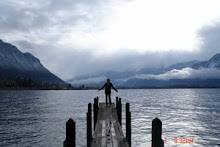January 6th
The alarm went off at 4:15 AM in order to make the morning train to Agra to see the Taj Mahal. When Monica greeted us in the lobby, she shared our first setback—the train was three hours behind schedule because of the fog. At first, the idea that fog could cause a three-hour delay in the train schedule seemed ridiculous, but after looking outside I was shocked. I can’t see more than 5 feet in front of me.
Plan two is to take our tour bus to Agra, which was originally just supposed to drive our luggage in the next city. Traffic is still noisy and the fog is still here, and we have a five-hour ride ahead of us.
Before departing from the YMCA, Gorab, the tour guide, encourages us to ask questions at any time. “Do not assume that things are the way they are for a reason,” he said. “Here in India, things are illogical. One has to be a good observer.”
Taj Mahal
The fog persisted during the rest of our trip to Agra. When we arrived in the city, a bunch of rickshaws were lined up waiting to carry us to the Taj. As part of a government effort to preserve historical landmarks, vehicles are not allowed to approach the Taj Mahal and have to park beyond a specified distance.

Taking a rickshaw to the Taj Mahal
As it turns out, the train delay and 5 hour bus ride to Agra bought us enough time for the fog to clear out. The sky was clear, and our group was able to get great pictures of the Taj. I can see why it is one of the seven wonders of the world (bonus points if you can name the six others). It makes you stop in your tracks and just stare, and wonder how anyone could dream up anything that beautiful.
Beauty, as Gorab explained, was the goal of the Taj’s creator, Prince Khurram the 5th son of the Mughal emperor, Jahangir. As he grew up, he far outshone his brothers in talent and charisma, earned the name Shah Jahan or “King of the World”. When his father passed, he battled with his brothers, eventually killing them to assume the throne.

No more fog! Wohoo!
In addition to the story behind the Taj, Gorab pointed out the following:
- The symmetry of the gardens. I could have gotten out my ruler.
- The Moghuls must have been exceedingly wealthy. There were a variety of semiprecious stones from all over the world set in the marble and calligraphied verses of the Quran along doorways and borders.
- The spires tilt to the left by 12 degrees. This is a precautionary measure so that, in the event of an earthquake, the spires would fall away from the building rather than on the masoleum.
- The amount of gardeners whispering “secret” camera angles to tourists…and then demanding a tip in return.
Red Fort of Agra
After lunch, we headed to the Red Fort of Agra, near the Taj Mahal. Made of red sandstone, it was the imperial city of the Mughal rulers. Inside are many smaller palaces, and audience halls.A lot of the buildings are made out of marble, with hollow walls filled with running water for a cooling effect.

Monkeys hanging out outside Agra Fort.
Women could not attend public hearings, but could listen through lattice work in the marble. If they had suggestions or comments on the hearing, they could pass their written suggestions through the gaps in the lattice.
Agra Fort was where one of Shah Jahan’s sons killed his two brothers, and imprisoned his father. Shah Jahan endured a life of isolation in a room from which he had a view of the Taj, a constant reminder of his late wife.

No comments:
Post a Comment